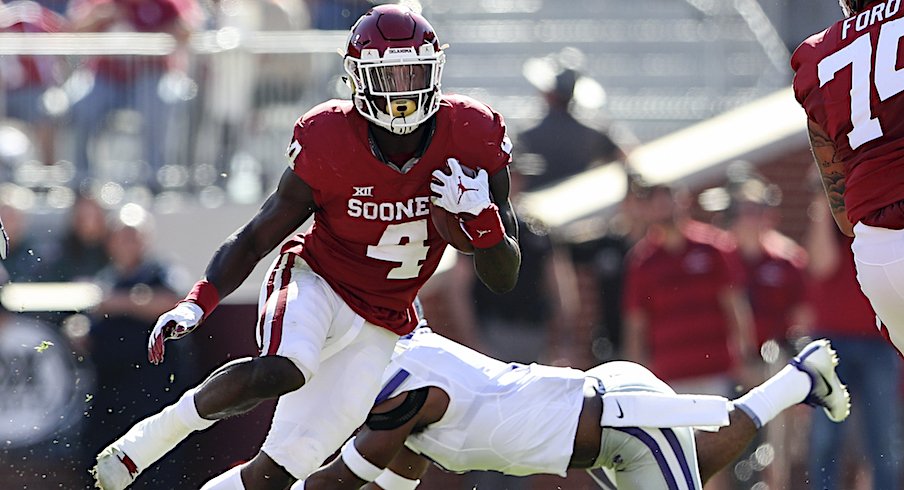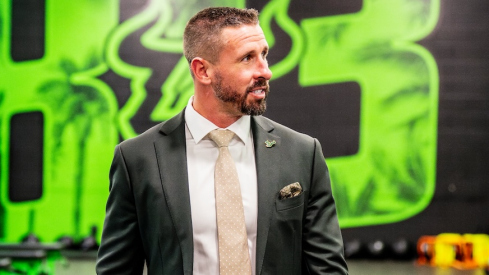There’s a lot to like about new Ohio State running back Trey Sermon.
A proven playmaker at the Power 5 level, Sermon rushed for more than 2,000 yards over the course of three seasons at Oklahoma – averaging more than six yards per carry – and while he didn’t necessarily face the toughest defensive competition in the Big 12, his film backs up his statistics to demonstrate his potential to be a big weapon out of the Buckeyes’ backfield in 2020.
Listed at 6-foot and 221 pounds at Oklahoma, Sermon is a big back who finishes runs strong and shows impressive balance on tape, while he also has good shiftiness in the open field for a back of his size and is an adept receiver. He isn’t a burner who will outrun defenses on speed alone, yet he showed a healthy amount of big-play ability as a Sooner, with 27 career plays of 20-plus yards.
By taking a look back at some highlights from Sermon’s Oklahoma career, it’s easy to see why Ohio State chose to bring him in as a potential upgrade for an otherwise inexperienced running back depth chart.
Balance to Keep Runs Going
The trait that stands out most when watching Sermon’s highlight reels is his balance to stay upright through contact, which leads to missed tackles and allows Sermon to extend plays into bigger gains. The following three Sermon runs against Iowa State, Army and Texas Tech exemplify that ability, as he ran through multiple tackles on each play, never allowing his legs to stop moving until he was taken to the ground or out of bounds.
A lesser back could have been stopped for a short gain on each of those plays, but his balance and strength allowed him to turn each of them into runs of at least 15 yards.
Wiggle to Make Defenders Miss
Sermon’s cutting ability isn’t as pronounced as his Ohio State predecessor J.K. Dobbins, but he has the foot quickness and instincts to smoothly maneuver away from defenders, and that wiggle is another trait that leads to many of his highlight-reel runs.
The following two plays against Baylor and Houston are prime examples of Sermon using his shiftiness to make defenders miss in space and creating big plays as a result.
By pairing that wiggle with his ability to keep running through contact, Sermon is a dangerous runner with a head of steam in the open field, forcing defenders to be sound in their tackling. If they aren’t, he’ll make them pay with big plays, like he did on each of the following three touchdowns runs against Oklahoma State, Florida Atlantic and Iowa State.
Finishing Power
Sermon isn’t the straight-line bulldozer that you might think of in a traditional power back, but he certainly shows the ability to use his size and strength to his advantage, especially once he’s moving at full speed. From lowering his shoulder through a defender to delivering a nasty stiff-arm, Sermon has demonstrated on repeated occasions that he can power his way to additional yardage.
Take the following run against Georgia, for example, on which Sermon finished with authority through Bulldogs cornerback Deandre Baker (who went on to be a first-round NFL draft pick).
On the following two runs against UCLA and Texas Tech, Sermon puts his stiff-arming ability on display.
Pass-Catching Fluidity
Being able to contribute in the passing game is an important trait for an Ohio State running back, and Sermon should be able to check that box, as well. He’s already shown that ability in Ohio Stadium – catching a pass for the first touchdown of his career in Oklahoma’s 31-16 win over Ohio State in 2017, the second game of his freshman year with the Sooners – and he continued to put natural hands on display throughout his three years in Norman.
When Sermon comes out of the backfield and has a pass thrown his way downfield, he doesn’t look out of his element, as he showed on the following catches against Iowa State, Kansas and Houston.
Enough Speed
Sermon doesn’t have the same kind of track speed that Ezekiel Elliott has at a similar size, but as you can see from many of the big plays above, he’s got enough speed to go long if he gets free in the open field.
His other traits make up for his lack of elite speed and burst, including his vision and patience, and if he gets enough space away from defenders, he can take advantage, like he did with a 60-yard run on the first play from scrimmage of Oklahoma’s win over Oklahoma State in 2018.
Solid Blocker
Just as important as being able to catch the ball out of the backfield for an Ohio State running back is being able to pass protect, and given that he will be lining up alongside a dual-threat quarterback in Justin Fields, the willingness to throw himself at a defender and block in the run game is crucial, too.
Fortunately for Sermon, he already has experience blocking for dual-threat quarterbacks – Baker Mayfield, Kyler Murray and Jalen Hurts for the past three years – and shows willingness and effectiveness as a blocker in both the passing and running games.
In the following three clips from Oklahoma’s 2018 Big 12 Championship Game win over Texas, Sermon picks up a pass protection in the pocket, moves in front of a defender to buy time for Murray to make a throw outside of the pocket and shows his ability to seal off the edge on a run block.
A Well-Rounded Skill Set
Altogether, Sermon has proven he has the skills to be an excellent runner out of the backfield while also contributing as both a pass-catcher and a blocker from the running back position. He has more elusiveness in his game than Master Teague, who was the frontrunner to be Ohio State’s starting running back in 2020 before injuring his Achilles this spring, and the graduate transfer certainly looks like he’ll be the new frontrunner to top the running back depth chart this fall.
Sermon was always in a rotation in his three years at Oklahoma, so it’s unproven whether he can be a bell-cow back week in and week out, though it’s likely that the Buckeyes will look to maintain a rotation of at least two backs with Teague (if healthy), Marcus Crowley or Steele Chambers alternating with Sermon for regular snaps. Sermon must also get fully healthy himself after suffering a knee injury that cut his season short after nine games last season.
After watching his film, though, it isn’t hard to see why Tony Alford and the Buckeyes identified Sermon as someone who could address their need for a veteran running back who can play immediately this season, nor is it hard to envision Sermon having a big year in scarlet and gray assuming he ultimately emerges as the starter.


